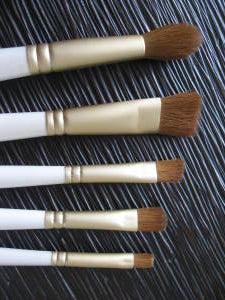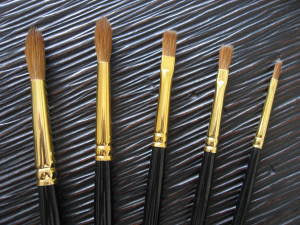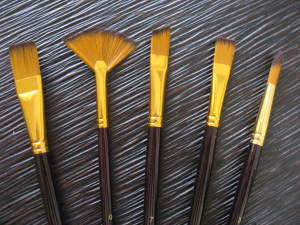Part 1: Selecting Hair Type

The sheer array of paint brushes available can seem quite overwhelming for the beginner or even the experienced artist. This article will help you pick which type of brush to use for each medium as well as choose which head shape is most suitable for you. Part 1 will cover the hair type and Part 2 will cover the shape styles.
Hair, you say?
Art paint brushes are usually either made from animal hair or synthetic hair. Most brushes are made from animal hair and the quality of the brush will depend on the grade of hair being used. Typically, the quality of an art paint brush is related to its spring (ability to bounce back into shape), feel and the evenness of the brush stroke.
Animal hair has some unique characteristics which make it a good choice for art paint brushes. Each hair has small micro-scales on the hair filament. These scales coupled with varying hair filament diameter, enable animal hair to efficiently store paint and deliver it more consistently over longer brush strokes. However, synthetic hair technology is fast catching up to animal hair fiber and offers a good alternative to expensive animal hairs.
Using the correct brush with the right medium
Kolinsky (Weasel)

Kolinsky paint brushes
Kolinsky hair is obtained from the tail-hair of a weasel (Mustela sibirica) and is used to make the finest quality art brushes. They are much sought after for their longevity, its ability to hold a fine point and excellent snap. Since the hair is now fairly rare, they command a premium price.
Given their great water holding capacity, they make ideal watercolor brushes, although they can be used for fine detailing with oils. Usually these are sold as short handle brushes, since they are predominantly used for watercolor painting, which is generally painted flat. A long handle can get in the way and be a hazard to your eyes!
Note than there is currently an import ban on Kolinsky hair into the US because of a recent inclusion on the CITES list. While it is not illegal to import to the US, there is now much more stringent documentation required.
Sable (Mink)

Sable paint brushes
Sable hair is from the mink(Martes zibellina), a special kind of marten that inhabits forest environments. A pure sable hair brush makes a fine brush. They will hold a full body paint, maintain a fine tip, have good snap and will be much cheaper than pure Kolinsky hair.
Sable brushes are usually used for watercolors, but they can also be used for fine finishing with oils (especially the courser grades).
Confusingly some manufacturers label brushes as “Kolinsky-sable” or “Kolinsky red sable”. This is not strictly speaking correct, as a Kolinsky and a sable are two different animals, although blends of the two hairs are possible.
The situation is further complicated by the term, ‘red sable’. Some manufacturers use this to denote sable blended with an inferior quality animal hair, while others use it as a term for pure sable hair. Either way, look for a pure sable or pure red sable brush for the highest quality paint brush.
Again these are generally sold in short handle form, although long handle variations are available if you look around.
Hog (Pig)
Commonly called bristle brushes, the hair in these paint brushes comes from pigs. The hair is stiff and holds little moisture, making them a poor choice for watercolor or gouache. They have great strength and resilience, making them excellent for oils and acrylics.
Be quite careful of cheap bristle brushes – they are weak and splay very easily, shed hair quite badly and leave stroke marks on your canvas. The best bristle brushes use Chungking bristle sourced from hogs raised in the Chungking region of Central China.
Chungking or Chonqing bristle has the longest flags. Flags are like split ends on the end of bristles. They are extremely important to the quality of the bristle. In theory, longer flags allow the brush to hold more paint and apply it more evenly.
Generally speaking, bristle brushes are used to shove thicker oils and acrylics around the canvas. Since much of the painting is done in a standing position, these are traditionally sold as long-handle brushes.
Synthetic

Synthetic paint brushes
The quality of synthetic hair in art paint brushes has improved greatly in the last two decades or so. There are synthetics which can mimic sable hair, mongoose hair and a variety of other high quality animal hairs. They can now rival the performance of expensive animal hairs for a fraction of the price.
Synthetics are extremely versatile and can be cheaper than high quality animal hair. Soft synthetics can have an excellent point and can carry water well, making them a good choice for watercolor and gouache. Stiffer brushes can work very well with acrylics and oils. They can also be blended with hairs like sable, to make cheaper, but high quality, brushes.
Since they are so versatile, you will be able to pick long or short handle varieties depending on which medium you want to work in.
What types of hair do I use?
Well this depends somewhat on the medium I am painting in. When I paint in watercolors I rely on synthetics to cover large areas and usually more expensive sable or Kolinsky brushes to work on more detailed areas.
I also use sable or Kolinsky to work on the fine detailing when I am oil painting, although the bulk of the oil painting I tend to do in hog or synthetic brushes. Since I tend to use oils quite thinly, synthetic brushes work great for me, but you might want to test that out for your own style.
When I paint in acrylics, I would say 90% of time I am using synthetics. They are cheap, don’t shed and don’t leave trailing brush strokes like some bristle brushes. To block in large areas of color, I might use bristle brushes and for the fine details areas I sometimes rely on my fine-tipped sable brushes.
Part 2
In Part 2 I will go over which brush heads to use to achieve different results. Make sure you catch that article!
Happy Painting :-)




